2015大学英语四级阅读理解技巧-仔细阅读篇
- 格式:ppt
- 大小:244.50 KB
- 文档页数:34
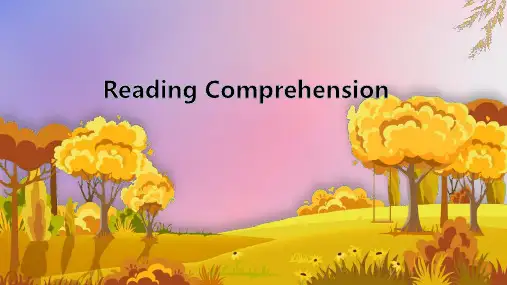
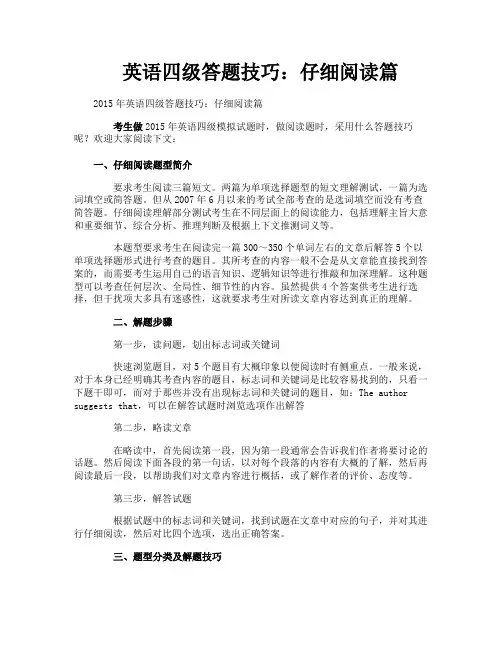
英语四级答题技巧:仔细阅读篇2015年英语四级答题技巧:仔细阅读篇考生做2015年英语四级模拟试题时,做阅读题时,采用什么答题技巧呢?欢迎大家阅读下文:一、仔细阅读题型简介要求考生阅读三篇短文。
两篇为单项选择题型的短文理解测试,一篇为选词填空或简答题。
但从2007年6月以来的考试全部考查的是选词填空而没有考查简答题。
仔细阅读理解部分测试考生在不同层面上的阅读能力,包括理解主旨大意和重要细节、综合分析、推理判断及根据上下文推测词义等。
本题型要求考生在阅读完一篇300~350个单词左右的文章后解答5个以单项选择题形式进行考查的题目。
其所考查的内容一般不会是从文章能直接找到答案的,而需要考生运用自己的语言知识、逻辑知识等进行推敲和加深理解。
这种题型可以考查任何层次、全局性、细节性的内容。
虽然提供4个答案供考生进行选择,但干扰项大多具有迷惑性,这就要求考生对所读文章内容达到真正的理解。
二、解题步骤第一步,读问题,划出标志词或关键词快速浏览题目,对5个题目有大概印象以便阅读时有侧重点。
一般来说,对于本身已经明确其考查内容的题目,标志词和关键词是比较容易找到的,只看一下题干即可,而对于那些并没有出现标志词和关键词的题目,如:The author suggests that,可以在解答试题时浏览选项作出解答第二步,略读文章在略读中,首先阅读第一段,因为第一段通常会告诉我们作者将要讨论的话题。
然后阅读下面各段的第一句话,以对每个段落的内容有大概的了解,然后再阅读最后一段,以帮助我们对文章内容进行概括,或了解作者的评价、态度等。
第三步,解答试题根据试题中的标志词和关键词,找到试题在文章中对应的句子,并对其进行仔细阅读,然后对比四个选项,选出正确答案。
三、题型分类及解题技巧根据大学英语阅读理解测试能力的要求,阅读理解的试题类型可以分为以下五大类:主旨题、细节题、语义题、推理题和观点态度题。
通过对历年大学英语四级试题的分析,阅读理解部分五类题型所占比重分别为:细节题占60%左右,主旨题和推理题各占15%左右,语义题和观点态度题各占5%左右。
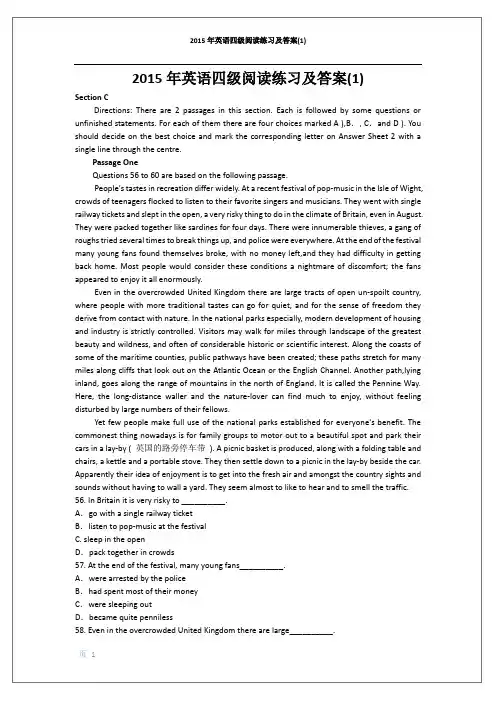
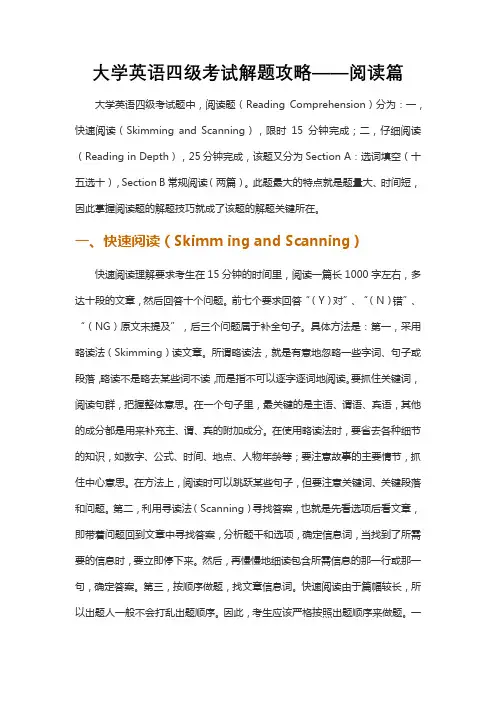
大学英语四级考试解题攻略——阅读篇大学英语四级考试题中,阅读题(Reading Comprehension)分为:一,快速阅读(Skimming and Scanning),限时15分钟完成;二,仔细阅读(Reading in Depth),25分钟完成,该题又分为Section A:选词填空(十五选十),Section B常规阅读(两篇)。
此题最大的特点就是题量大、时间短,因此掌握阅读题的解题技巧就成了该题的解题关键所在。
一、快速阅读(Skimm ing and Scanning)快速阅读理解要求考生在15分钟的时间里,阅读一篇长1000字左右,多达十段的文章,然后回答十个问题。
前七个要求回答“(Y)对”、“(N)错”、“(NG)原文未提及”,后三个问题属于补全句子。
具体方法是:第一,采用略读法(Skimming)读文章。
所谓略读法,就是有意地忽略一些字词、句子或段落,略读不是略去某些词不读,而是指不可以逐字逐词地阅读。
要抓住关键词,阅读句群,把握整体意思。
在一个句子里,最关键的是主语、谓语、宾语,其他的成分都是用来补充主、谓、宾的附加成分。
在使用略读法时,要省去各种细节的知识,如数字、公式、时间、地点、人物年龄等;要注意故事的主要情节,抓住中心意思。
在方法上,阅读时可以跳跃某些句子,但要注意关键词、关键段落和问题。
第二,利用寻读法(Scanning)寻找答案,也就是先看选项后看文章,即带着问题回到文章中寻找答案,分析题干和选项,确定信息词,当找到了所需要的信息时,要立即停下来。
然后,再慢慢地细读包含所需信息的那一行或那一句,确定答案。
第三,按顺序做题,找文章信息词。
快速阅读由于篇幅较长,所以出题人一般不会打乱出题顺序。
因此,考生应该严格按照出题顺序来做题。
一般第一题到文章前面找答案,最后一题到文章后半部分找答案。
信号词常用来连接细节或是强调内容,并可完成段落的转换,暗示读者下文要讲的内容,标志出作者要提出一个新的思想或者观点,或者是作者要对所论述的观点举例说明,或者要详细论述同一观点。
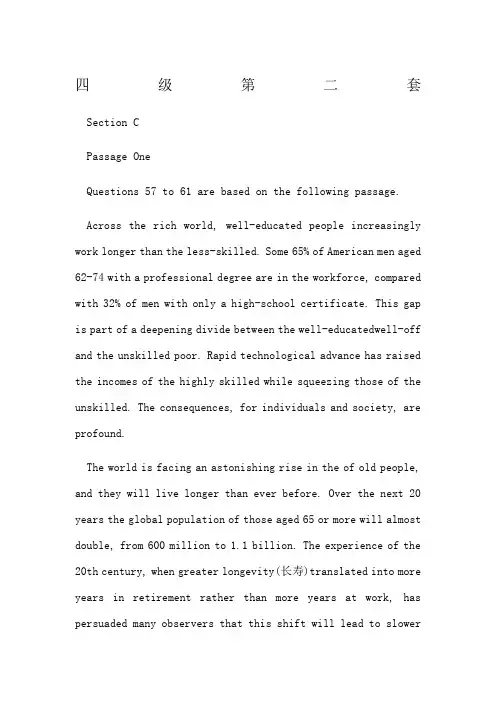
四级第二套Section CPassage OneQuestions 57 to 61 are based on the following passage.Across the rich world, well-educated people increasingly work longer than the less-skilled. Some 65% of American men aged 62-74 with a professional degree are in the workforce, compared with 32% of men with only a high-school certificate. This gap is part of a deepening divide between the well-educatedwell-off and the unskilled poor. Rapid technological advance has raised the incomes of the highly skilled while squeezing those of the unskilled. The consequences, for individuals and society, are profound.The world is facing an astonishing rise in the of old people, and they will live longer than ever before. Over the next 20 years the global population of those aged 65 or more will almost double, from 600 million to 1.1 billion. The experience of the 20th century, when greater longevity(长寿)translated into more years in retirement rather than more years at work, has persuaded many observers that this shift will lead to slowereconomic growth, while the swelling ranks of pensioners will create government budget problems.But the notion of a sharp division between the working young and the idle old misses a new trend, the growing gap between the skilled and the unskilled. Employment rates are failing among younger unskilled people, whereas older skilled folk are working longer.The divide is most extreme in America, where well-educated baby-boomers(二战后生育高峰期出生的美国人)areputting off retirement while many less-skilled younger people have abandoned policies that used Xto retire early. Rising life expectancy(预期生命),combined with the replace- Xpension plans with less generous defined-contribution ones, means that even the better-off must work longer to have a comfortable retirement. But the changing nature of work also plays a big role. Pay has risen sharply for the highly educated, and those people continue to reap rich rewards into old age because these days the educated elderly are more productive that the preceding generation. Technological charge may well reinforce that shift; the skills that complement computers, from management knowhow to creativity, do not necessarily decline with age.57.What is happening in the workforce in rich countriesA.Younger people are replacing the elderly.B.Well-educated people tend to work longer.C.Unemployment rates are rising year after year.D.People with no collage degree do not easily find work.【答案】B58.What has helped deepen the divide between the well-off and the poorA.Longer life expectancies.B.A rapid technological advance.C.Profound changes in the workforce.D.A growing number of the well-educated.【答案】B59.What do many observers predict in view of the experience of the experience of the 20th centuryA.Economic growth will slow down.ernment budgets will increase.C.More people will try to pursue higher education.D.There will be more competition in the job market.【答案】A60.What is the result of policy changes in European countriesA.Unskilled workers may choose to retire early.B.Morepeople have to receive in-service training.C.Even wealthy people must work longer to live comfortably in retirement.D.Peoplemay be able to enjoy generous defined-benefits from pension plans.【答案】C61.What is characteristic of work in the 21st centuryputers will do more complicated work.B.More will be the educated young.C.Most jobs to be done will be creative ones.D.Skills are highly valued regardless of age.【答案】DPassage TwoQuestions 62 to 65 are based on the following passage.Some of the world's most sign significant problems hit headlines. One example comes from agriculture. Food riots and hunger make news. But the trend lying behind these matters is rarely talked about. This is the decline in the growth in yields of some of the world's major crops. A new study by the University of Minnesota and McGill University in Montreal looks at where, and how far, this decline is occurring.The authors take a vast number of data points for the four most important crops: rice, wheat, corn and soyabeans(大豆). They find that on between 24% and 39% of all harvested areas, the improvement in yields that took place before the 1980s slowed down in the 1990s and 2000s.There are two worrying features of the slowdown. One is that it has been particularly sharp in the world's most populous(人口多的)countries, India and China. Their ability to feed themselves has been an important source of relative stability both within the countries and on world food markets. That self-sufficiency cannot be taken for granted if yields continue to slow down or reverse.Second,yield growth has been lower in wheat and rice than in corn and soyabeans. This is problematic because wheat and rice are more important as foods, accounting for around half of all calories consumed. Corn and soyabeans are more important as feed grains. The authors note that "we have preferentially focused our crop improvement efforts on feeding animals and cars rather than on crops that feed people and are the basis of food security in much of the world."The report qualifies the more optimistic findings of another new paper which suggests that the world will not have to dig up a lot more land for farming in order to feed 9 billion people in 2050, as the Food and Agriculture Organisation has argued. Instead, it says, thanks to slowing population growth, land currently ploughed up for crops might be able to revert(回返)to forest or wilderness. This could happen. The trouble is that the forecast assumes continued improvements in yields, which may not actually happen.62.What does the author try to draw attention toA.Food riots and hunger in the world.B.The decline of the grain yield growth.C.News headlines in the leading media.D.The food supply in populous countries.【答案】B63.Why does the author mention India and China in particularA.Their self-sufficiency is vital to the stability of world food markets.B.Their food yields have begun to decrease sharply in recent years.C.Their big populations are causing worldwide concerns.D.Their food self-sufficiency has been taken for granted.【答案】A64.What does the new study by the two universities say about recent crop improvement effortsA.They fail to produce the same remarkable results as before the 1980s.B.They contribute a lot to the improvement of human food production.C.They play a major role in guaranteeing the food security of the world.D.they focus more on the increase of animal feed than human food grains.【答案】D65.What does the Food and Agriculture Organisation say about world food production in the coming decadesA.The growing population will greatly increase the pressure on world food supplies.B.The optimistic prediction about food production should be viewed with caution.C.The slowdown of the growth in yields of major food crops will be reversed.D.The world will be able to feed its population without increasing farmland.【答案】D66.How does the author view the argument of the Food and Agriculture OrganisationA.It is built on the findings of a new study.B.It is based on a doubtful assumption.C.It is backed by strong evidence.D.It is open to further discussion.【答案】B四级第一套Section CPassage OneQuestion 57 to 61 are based on the following passage.If you think a high-factor sunscreen(防晒霜)keeps you safe from harmful rays, you may be wrong. Research in this week's Nature shows that while factor 50 reduces the number of melanomas(黑瘤)and delays their occurrence, it can't prevent them. Melanomas are the most aggressive skin cancers. You have a higher risk if you have red or blond hair, fair skin, blue or green eyes, or sunburn easily, or if a close relative has had one. Melanomas are more common if you have periodic intense exposure to the sun. Other skin cancers are increasingly likely with long-term exposure.There is continuing debate as to how effective sunscreenis in reducing melanomas—the evidence is weaker than it is for preventing other types of skin cancer. A 2011 Australian study of 1,621 people found that people randomly selected to apply sunscreen daily had half the rate of melanomas of people who used cream as needed. A second study, comparing 1,167 people with melanomas to 1,101 who didn't have the cancer, found that using sunscreen routinely, alongside other protection such as hats, long sleeves or staying in the shade, did give some protection. This study said other forms of sun protection—not sunscreen—seemed most beneficial. The study relied on people remembering what they had done over each decade of their lives, so it's not entirely reliable. But it seems reasonable to think sunscreen gives people a false sense of security in the sun.Many people also don't use sunscreen properly-applying insufficient amounts, failing to reapply after a couple of hours and staying in the sun too long. It is sunburn that is most worrying-recent shows five episodes of sunburn in the teenage years increases the risk of all skin cancers.The good news is that a combination of sunscreen and covering up can reduce melanoma rates, as shown by Australianfigures from their slip-slop-slap campaign. So if there is a heat wave this summer, it would be best for us, too, to slip on a shirt, slop on(抹上)sunscreen and slap on a hat.57.【题干】What is people's common expectation of a high-factor sunscreenA.It will delay the occurrence of skin cancer.B.It will protect them from sunburn.C.It will keep their skin smooth and fair.D.It will work for people of any skin color.【答案】B58.【题干】What does the research in Nature say about a high-factor sunscreenA.It is ineffective in preventing melanomas.B.It is ineffective in case of intense sunlight.C.It is ineffective with long-term exposure.D.It is ineffective for people with fair skin.【答案】C59.【题干】What do we learn from the 2011Australian studyof 1,621 peopleA.Sunscreen should be applied alongside other protection measures.B.High-risk people benefit the most from the application of sunscreen.C.Irregular application of sunscreen does women more harm than good.D.Daily application of sunscreen helps reduce the incidence of melanomas.【答案】D60.【题干】What does the author say about the second Australian studyA.It misleads people to rely on sunscreen for protection.B.It helps people to select the most effective sunscreen.C.It is not based on direct observation of the subjects.D.It confirms the results of the first Australian study.【答案】D61.【题干】What does the author suggest to reduce melanomaratesing both covering up and sunscreen.B.Staying in the shade whenever possible.ing covering up instead of sunscreen.D.Applying the right amount of sunscreen.【答案】APassage TwoQuestions 62 to 65are based on the following passage.Across the rich world, well-educated people increasingly work longer than the less-skilled. Some 65% of American men aged 62-74 with a professional degree are in the workforce, compared with 32% of men with only a high-school certificate. This gap is part of a deepening divide between the well-educated well-off and the unskilled poor. Rapid technological advance has raised the incomes of the highly skilled while squeezing those of the unskilled. The consequences, for individuals and society, are profound.The world is facing an astonishing rise in the number of old people, and they will live longer than ever before. Overthe next 20 years the global population of those aged 65 or more will almost double, from 600 million to 1.1 billion. The experience of the 20th century, when greater longevity(长寿)translated into more years in retirement rather than more years at work, has persuaded many observers that this shift will lead to slower economic growth, while the swelling ranks of pensioners will create government budget problems.But the notion of a sharp division between the working young and the idle old misses a new trend, the growing gap between the skilled and the unskilled people, whereas older skilled folk are working longer. The divide is most extreme in America, where well-educated baby-boomers(二战后生育高峰期出生的美国人)are putting off retirement while many less-skilled younger people have dropped out of the workforce.Policy is partly responsible. Many European governments have abandoned policies that used to encourage people to retire early. Rising life expectancy(预期寿命), combined with the replacement of generous defined-benefit pension plans with less generous defined-contribution ones, means that even the better-off must work longer to have a comfortable retirement. But the changing nature of work also plays a big role. Pay hasrisen sharply for the highly educated, and those people continue to reap rich rewards into old age because these days the educated elderly are more productive than the preceding generation. Technological change may well reinforce that shift: the skills that complement computers, from management knowhow to creativity, do not necessarily decline with age.62.【题干】What is happening in the workforce in rich countriesA.Younger people are replacing the elderly.B.Well-educated people tend to work longer.C.Unemployment rates are rising year after year.D.People with no college degree do not easily find work.【答案】B63.【题干】What has helped deepen the divide between the well-off and the poorA.Longer life expectancies.B.Profound changes in the workforce.C.A rapid technological advance.D.A growing number of the well-educated.【答案】C64.【题干】What do many observers predict in view of the experience of the 20th centuryA.Economic growth will slow down.ernment budgets will increase.C.More people will try to pursue higher education.D.There will be more competition in the job market. 【答案】A65.【题干】What is the result of policy changes in European countriesA.Unskilled workers may choose to retire early.B.More people have to receive in-service training.C.Even wealthy people must work longer to live comfortably in retirement.D.People may be able to enjoy generous defined-benefits from pension plans.【答案】C66.【题干】What is characteristic of work in the 21st centuryputers will do more complicated work.B.More will be taken by the educated young.C.Most jobs to be done will be creative ones.D.Skills are highly valued regardless of age.【答案】D四级卷三56. C) The decline of the grain yield growth.57. A) Their self-sufficiency is vital to the stability of world food markets.58.D) They focus more on the increase of animal feed than human food grains.59. D) The world will be able to feed its population without increasing farmland.60. B) It is based on a doubtful assumption.61. A)More men taking an extended parental leave.62. C) Their number is too small to make a difference。
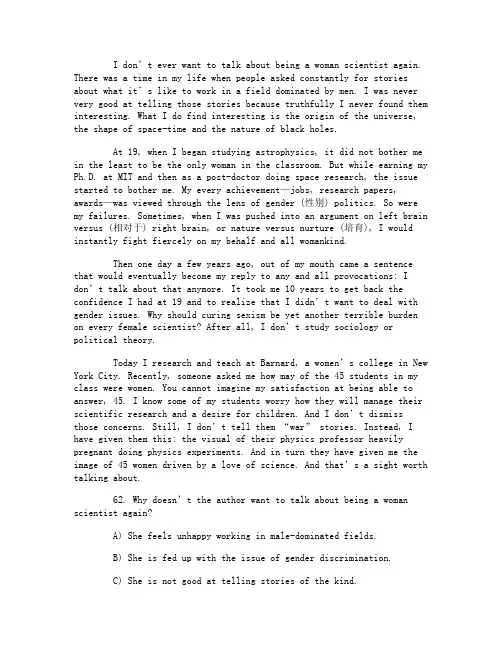
I don’t ever want to talk about being a woman scientist again. There was a time in my life when people asked constantly for stories about what it’s like to work in a field dominated by men. I was never very good at telling those stories because truthfully I never found them interesting. What I do find interesting is the origin of the universe, the shape of space-time and the nature of black holes.At 19, when I began studying astrophysics, it did not bother me in the least to be the only woman in the classroom. But while earning my Ph.D. at MIT and then as a post-doctor doing space research, the issue started to bother me. My every achievement—jobs, research papers, awards—was viewed through the lens of gender (性别) politics. So were my failures. Sometimes, when I was pushed into an argument on left brain versus (相对于) right brain, or nature versus nurture (培育), I would instantly fight fiercely on my behalf and all womankind.Then one day a few years ago, out of my mouth came a sentence that would eventually become my reply to any and all provocations: I don’t talk about that anymore. It took me 10 years to get back the confidence I had at 19 and to realize that I didn’t want to deal with gender issues. Why should curing sexism be yet another terrible burden on every female scientist? After all, I don’t study sociology or political theory.Today I research and teach at Barnard, a women’s college in New York City. Recently, someone asked me how may of the 45 students in my class were women. You cannot imagine my satisfaction at being able to answer, 45. I know some of my students worry how they will manage their scientific research and a desire for children. And I don’t dismiss those concerns. Still, I don’t tell them “war” stories. Instead, I have given them this: the visual of their physics professor heavily pregnant doing physics experiments. And in turn they have given me the image of 45 women driven by a love of science. And that’s a sight worth talking about.62. Why doesn’t the author want to talk a bout being a woman scientist again?A) She feels unhappy working in male-dominated fields.B) She is fed up with the issue of gender discrimination.C) She is not good at telling stories of the kind.D) She finds space research more important.63. From Paragraph 2, we can infer that people would attribute the author’s failures to ________.A) the very fact that she is a womanB) her involvement in gender politicsC) her over-confidence as a female astrophysicistD) the burden she bears in a male-dominated society64. What did the author constantly fight against while doing her Ph.D. and post-doctoral research?A) Lack of confidence in succeeding in space science.B) Unfair accusations from both inside and outside her circle.C) Peop le’s stereotyped attitude toward female scientists.D) Widespread misconceptions about nature and nurtured.65. Why does the author feel great satisfaction when talking about her class?A) Female students no longer have to bother about gender issues.B) Her students’ performance has brought back her confidence.C) Her female students can do just as well as male students.D) More female students are pursuing science than before.66. What does the image the author presents to her students suggest?A) Women students needn’t have the concerns of her generation.B) Women have more barriers on their way to academic success.C) Women can balance a career in science and having a family.D) Women now have fewer problems pursuing a science career.62. D 63. A 64. C 65.D 66. CBy almost any measure, there is a boom in Internet-based instruction. In just a few years, 34 percent of American universities have begun offering some form of distance learning (DL), and among the larger schools, it’s close to 90 percent. If you doubt the popularityof the trend, you probably haven’t heard of the University of Phoenix.It grants degrees entirely on the basis of online instruction. Itenrolls 90,000 students, a statistic used to support its claim to be the largest private university in the country.While the kinds of instruction offered in these programs will differ, DL usually signifies a course in which the instructors post syllabi (课程大纲), reading assignment, and schedules on Websites, and students send in their assignments by e-mail. Generally speaking, face-to-face communication with an instructor is minimized or eliminated altogether.The attraction for students might at first seem obvious. Primarily, there’s the convenience promised by cour ses on the Net: you can do the work, as they say, in your pajamas (睡衣). But figuresindicate that the reduced effort results in a reduced commitment to the course. While dropout rate for all freshmen at American universities is around 20 percent, the rate for online students is 35 percent. Students themselves seem to understand the weaknesses inherent in the setup. In a survey conducted for Cornell, the DL division of Cornell University,less than a third of the respondents expected the quality of the online course to be as good as the classroom course.Clearly, from the schools’ perspective, there’s a lot of money to be saved. Although some of the more ambitious programs require new investments in servers and networks to support collaborative software, most DL courses can run on existing or minimally upgraded (升级) systems. The more students who enroll in a course but don’t come to campus, themore school saves on keeping the lights on in the classrooms, paying doorkeepers, and maintaining parking lots. And, while there’s evidence that instructors must work harder to run a DL course for a variety of reasons, they won’t be paid any more, and might well be paid less.57. What is the most striking feature of the University of Phoenix?A) All its courses are offered online.B) Its online courses are of the best quality.C) It boasts the largest number of students on campusD) Anyone taking its online courses is sure to get a degree.58.According to the passage , distance learning is basically characterized by_____A) a considerable flexibility in its academic requirementsB) the great diversity of students’ academic backgroundsC) a minimum or total absence of face-to-face instructionD) the casual relationship between students and professors59. Many students take Internet -based courses mainly because they can_____A) earn their academic degrees with much less effortB) save a great deal on traveling and boarding expensesC) select courses from various colleges and universitiesD) work on the required courses whenever and wherever60. What accounts for the high drop-out rates for online students?A) There is no strict control over the academic standards of the courses.B) The evaluation system used by online universities is inherently weak.C) There is no mechanism to ensure that they make the required effort.D) Lack of classroom interaction reduces the effectiveness of instruction.61. According to the passage, universities show great enthusiasm for DL programs for the purpose of_____A) building up their reputationB) cutting down on their expensesC) upgrading their teaching facilitiesD) providing convenience for student57. A. All its courses are offered online.58. C. a minimum or total absence of face-to-face instruction.59. D. work on the required courses whenever and wherever.60. C. There is no mechanism to ensure that they make the required effort.61. B. cutting down on their expenses.。
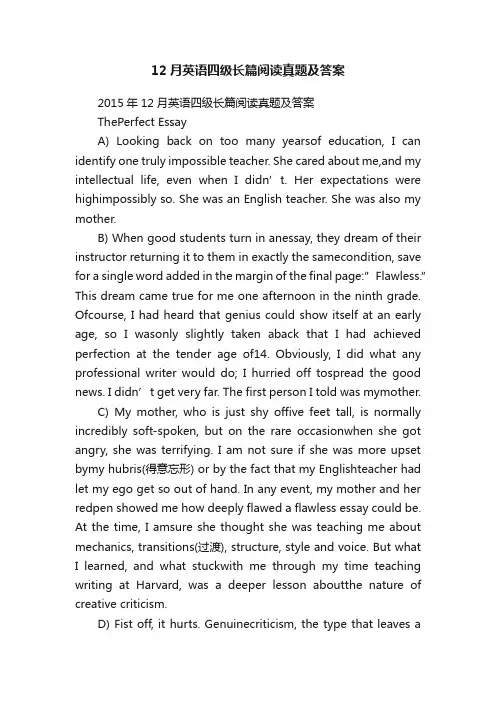
12月英语四级长篇阅读真题及答案2015年12月英语四级长篇阅读真题及答案ThePerfect EssayA) Looking back on too many yearsof education, I can identify one truly impossible teacher. She cared about me,and my intellectual life, even when I didn’t. Her expectations were highimpossibly so. She was an English teacher. She was also my mother.B) When good students turn in anessay, they dream of their instructor returning it to them in exactly the samecondition, save for a single word added in the margin of the final page:”Flawless.” This dream came true for me one afternoon in the ninth grade. Ofcourse, I had heard that genius could show itself at an early age, so I wasonly slightly taken aback that I had achieved perfection at the tender age of14. Obviously, I did what any professional writer would do; I hurried off tospread the good news. I didn’t get very far. The first person I told was mymother.C) My mother, who is just shy offive feet tall, is normally incredibly soft-spoken, but on the rare occasionwhen she got angry, she was terrifying. I am not sure if she was more upset bymy hubris(得意忘形) or by the fact that my Englishteacher had let my ego get so out of hand. In any event, my mother and her redpen showed me how deeply flawed a flawless essay could be. At the time, I amsure she thought she was teaching me about mechanics, transitions(过渡), structure, style and voice. But what I learned, and what stuckwith me through my time teaching writing at Harvard, was a deeper lesson aboutthe nature of creative criticism.D) Fist off, it hurts. Genuinecriticism, the type that leaves alasting mark on you as a writer, also leavesan existential imprint(印记) on you asa person. I have heard people say that a writer should never take criticismpersonally. I say that we should never listen to these people.E) Criticism, at its best, isdeeply personal, and gets to the heart of why we write the way we do. Theintimate nature of genuine criticism implies something about who is able togive it, namely, someone who knows you well enough to show you how your mentallife is getting in the way of good writing. Conveniently, they are also thepeople who care enough to see you through this painful realization. For me ittook the form of my first, and I hope only, encounter with writer’s block—I wasnot able to produce anything for three years.F) Franz Kafka once said:” Writingis utter solitude(独处), the descentinto the cold abyss(深渊) ofoneself. “My mother’s criticism had shown me that Kafka is right about the coldabyss, and when you make the introspective (内省的) decent that writing requires you are out always pleased by whatyou find.” But, in the years that followed, her sustained tutoring suggestedthat Kafka might be wrong about the solitude. I was lucky enough to find acritic and teacher who was willing to make the journey of writing with me. “Itis a thing of no great difficulty,” according to Plutarch, “to raise objectionsagainst another man’s speech, it is a very easy matter; but to produce a betterin its place is a work extremely troublesome.” I am sure I wrote essays in thelater years of high school without my mother’s guidance, but I can’t recallthem. What I remember, however, is how we took up the “extremely troublesome”work of ongoing criticism.G) There are two ways to interpretPlutarch when he suggests that a critic should be able to produce “a better inits place.” Ina straightforward sense, he could mean that a critic must bemore talented than the artist she critiques(评论). My mother was well covered on this count. But perhaps Plutarch issuggesting something slightly different, something a bit closer to MarcusCicero’s claim that one should “criticize by creation, not by finding fault.”Genuine criticism creates a precious opening for an author to become better onthis own terms—a process that is often extremely painful, but also almostalways meaningful.H) My mother said she would helpme with my writing, but fist I had myself. For each assignment, I was write thebest essay I could. Real criticism is not meant to find obvious mistakes, so ifshe found any—the type I could have found on my own—I had to start fromscratch. From scratch. Once the essay was “flawless,” she would take an eveningto walk me through my errors. That was when true criticism, the type thatchanged me as a person, began.I) She criticized me when Iincluded little-known references and professional jargon(行话). She had no patience for brilliant but irrelevant figures ofspeech. “Writers can’t bluff(虚张声势) theirway through ignorance.” T hat was news to me—I would need to find another way tostructure my daily existence.J) She trimmed back my flowerylanguage, drew lines through my exclamation marks and argued for the value ofrestraint in expression. “John,” she almost whispered. I learned in to hearher:”I can’t hear you when you shout at me.” So I stopped shouting andbluffing, and slowly my writing improved.K) Somewhere along the way I setaside my hopes of writing that flawless essay. But perhaps I missed somethingimportant in my mother’s lessons about creativity and perfection. Perhaps thepoint of writing the flawless essay was not to give up, but tonever willinglyfinish. Whitman repeatedly reworded “Song of Myself” between 1855 and 1891.Repeatedly. We do our absolute best wiry a piece of writing, and come as closeas we can to the ideal. And, for the time being, we settle. In critique,however, we are forced to depart, to give up the perfection we thought we hadachieved for the chance of being even a little bit better. This is the lesson Itook from my mother. If perfection were possible, it would not be motivating.46. The author was advised against theimproper use of figures of speech.47. The author’s mother taught him avaluable lesson by pointing out lots of flaws in his seemingly perfect essay.48. A writer should polish his writingrepeatedly so as to get closer to perfection.49. Writers may experience periods of timein their life when they just can’t produce anything.50. The author was not much surprised whenhis school teacher marked his essay as “flawless”.51. Criticizing someone’s speech is said tobe easier than coming up with a better one.52. The author looks upon his mother as hismost demanding and caring instructor.53. The criticism the author received fromhis mother changed him as a person.54. The author gradually improved hiswriting by avoiding fact language.55. Constructive criticism gives an authora good start to improve his writing.参考答案46. I,根据关键信息“figures of speech”定位到I段,原文中该词组前面的形容词是“irrelevant”,和句中的“improper”为同义替换关系。
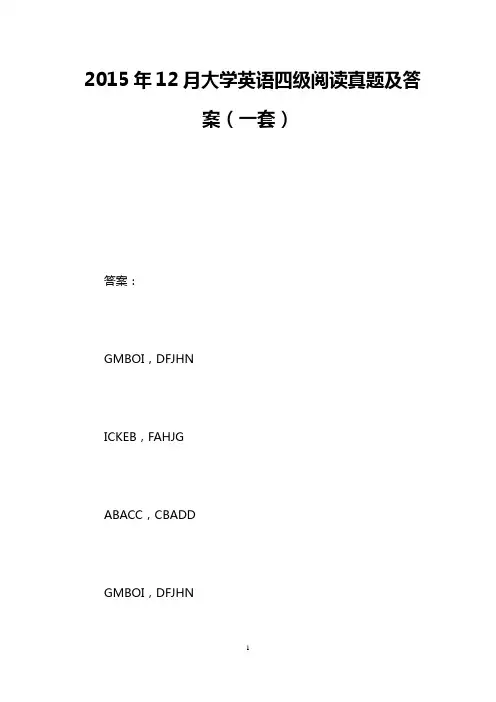
2015年12月大学英语四级阅读真题及答案(一套)答案:GMBOI,DFJHNICKEB,FAHJGABACC,CBADDGMBOI,DFJHNICKEB,FAHJGABACC,CBADD2015年12月四级考试如期进行。
从笔者拿到的套题的阅读部分来看,整体难度适中,较往年趋于平稳。
选词填空部分(关于《children s cognitive abilities儿童认知能力》)首先从选项设计上看,四大词性(名、动、形、副)考查数量分布均匀(3233),不确定形式(Ving 和Ved)共4个,另外只有advocate一个词属于一词多性的情况,相对选项设计总体难度属于中等偏易。
再看文章部分,谈论的是关于儿童认知(children s cognitive abilities)方面的知识的话题,属于小冷门,但文章语言表达适中,且短句占主体,平衡了话题生僻对考试带来的解题障碍。
其中cognitive还给出了中文注解,也正好应验了我们反复强调的中文重要性的应试知识要点。
同时,空格设置处的词性相对比较容易判断,例如,名词前给出了单复数的区别的代词those作为提示,又例如,非谓语动词只考查了一个正在进行时,而做后置定语或状语的高难度应用本篇没有涉及。
段落匹配部分(The Perfect Essay)首先看备选的十个小标题,均无长难句,同时出现大量重复信息,例如除了与文章title 本身密切相关的essay ,flaw,flawless,perfection以外,还有mother,criticism,从而能顺利预测出文章谈及的是通过母亲的有建设性的批评,提升作者的写作能力。
这也是我们要求的先题后文解决段落匹配的技巧。
从长文章的段落设计上看,一共11段(K),属于段落数量适中的情况,也为匹配选择降低难度。
但对于所谓长阅读文章只看开头结尾的谬论,用真题再次给予回击,十道匹配中至少3题涉及段落中间部分,2题涉及对全段进行总结。
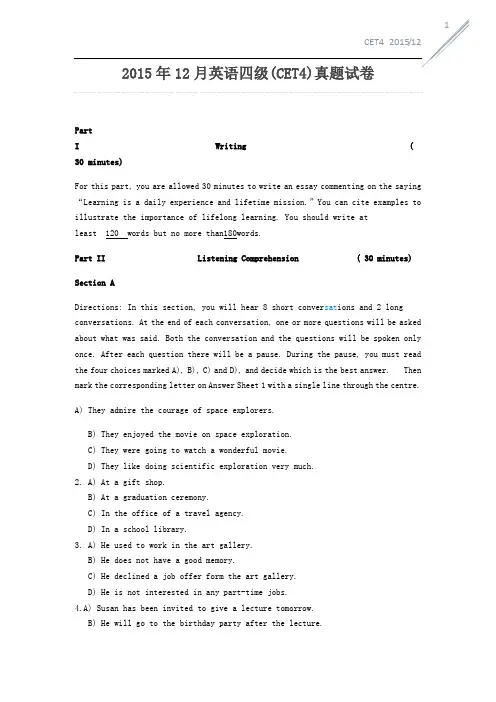
PartI Writing (30 minutes)For this part, you are allowed 30 minutes to write an essay commenting on the saying “Learning is a daily experience and lifetime mission.”You can cite examples to illustrate the importance of lifelong learning. You should write atleast 120 words but no more than180words.Part II Listening Comprehension ( 30 minutes)Section ADirections: In this section, you will hear 8 short conver sat ions and 2 long conversations. At the end of each conversation, one or more questions will be asked about what was said. Both the conversation and the questions will be spoken only once. After each question there will be a pause. During the pause, you must read the four choices marked A), B), C) and D), and decide which is the best answer. Then mark the corresponding letter on Answer Sheet 1 with a single line through the centre.A) They admire the courage of space explorers.B) They enjoyed the movie on space exploration.C) They were going to watch a wonderful movie.D) They like doing scientific exploration very much.2. A) At a gift shop.B) At a graduation ceremony.C) In the office of a travel agency.D) In a school library.3. A) He used to work in the art gallery.B) He does not have a good memory.C) He declined a job offer form the art gallery.D) He is not interested in any part-time jobs.4.A) Susan has been invited to give a lecture tomorrow.B) He will go to the birthday party after the lecture.C) The woman should have informed him earlier.D) He will be unable to attend the birthday party.5.A) Reward those having made good pro gre ss.B) Set a deadline for the staff to meet.C) Assign more workers to the project.D) Encourage the staff to work in small groups.6. A) The way to the visitor’s parking.B) The rate for parking in Lot C.C) How far away the parking lot is.D) Where she can leave her car.7. A) He regrets missing the classes.B) He plans to take the fitness classes.C) He is looking forward to a better life.D) He has benefited form exercise.8.A) How to ? work efficiency.B) How to select secretaries.C)The responsibilities of secretaries.D) The secretaries in the man’s company.Conver sat ion OneQuestions 9 to 11 are based on the conversation you have just heard.9.A) It is more difficult to learn than English.B) It is used by more people than English.C) It will be as commonly used as English.D) It will eventually bec ome a world language.10.A) It has words words from many languages,B) Its popularity with the common people.C) The influence of the British Empire.D) The effect of the Industrial Revolution.11.A) It includes a lot of words form other languages.B) It has a growing number of newly coined words,C) It can be easily picked up by overseas travelers.D) It is the largest among all languages in the world. Conversation 2Questions 12 to 15 are based on the conversation you have just heard.12.A) To return some goods.B) To apply for a job.C) To place an order.D) To make a complaint.13. A) He has become somewhat impatient with the woman.B) He is not familiar with the exact details of goods.C) He has not worked in the sales department for long.D) He works on a part-time basis for the company.14. A) It is not his responsibility.B) It will be free for large orders.C) It costs 15 more for express delivery.D) It depends on a number of factors.15.A) Report the information to her superior.B) Pay a visit to the saleswoman in charge.C) Ring back when she comes to a decision.D) Make inquiries with some other companies.Section BDirections:In this section, you will hear 3 short passages. At the end of each passage, you will hear some questions. Both the passage and the questions will be spoken only once. After you hear a question, you must choose the best answer from the four choices marked A), B), C) and D ). Then mark the corresponding letter on Answer Sheet I with a single line through the centre.Passage OneQuestions 16 to 18 are based on the passage you have just heard.16. A) No one knows exactly where they were ??B) No one knows for sure when thy came into being.C) No one knows for what purpose they were ?D) No one knows what they will17. A) Carry ropes across rivers.B) Measure the speed of wind.C) Pass on secret messages.D) Give warnings of danger.18. A) To protect houses against lightning.B) To test the effects of the lightning rod.C) To find out the strength of silk for kites.D) To prove the lightning is electricity.Passage TwoQuestions 19 to 22 are based on the passage you have just heard.19.A) She enjoys teaching languages.B) She can speak several languages.C) She was trained to be an interpreter.D) She was born with a talent for languages.20. A) They acquire an immunity to culture shock.B) They would like to live abroad permanently.C) They want to learn as many foreign languages as possible.D) They have an intense interest in cross-cultural interactions.21.A) She bec ame an expert in horse racing.B) She got a chance to visit several European countries.C) She was able to translate for a German sports judge.D) She learned to appreciate classical music.22. A) Taste the beef and give her comment.B) Take part in a cooking competition.C) Teach vocabulary for food in ??D) Give cooking lessons onPassage ThreeQuestions 23 to 25 are based on the passage you have just heard.23. A) He had only a third-grade education.B) He once threatened to kill his teacher.C) He gre w up in a poorD) He often helped his24.A) Careless.B) Stupid.C) Brave.D) Active.25.A) Write two book reports a week.B) Keep a diary.C) Help with housework.D) Watch education??Section CDirections:In this section, you will hear a passage three times. When the passage is read for the first time, you should listen carefully for its general idea. When the passage is read for the second time, you are required to fill in the blanks with the exact words you have just heard. Finally, when the passage is read for the third time, you should check what you have written.When you look up at the night sky, what do you see?There areother bodies out there besides the moon and stars. One of the most of this is a comet. Comets were formed around the same the earth was formed. They are made up of ice and other frozen liquids and gasses. these dirty snow balls begin to orbit the sun just as the planets do. As a comet gets closer to the sun, some gasses in it begin to unfreeze. They combine with dust particles from the comet to form a huge cloud. As the comet gets even nearer to the sun and solar wind blows the cloud behind the comet thus forming its tail. The tail and generally fuzzy atmosphere around the cometare that can help this phenomenon in the night sky. In any given year,about dozen known comets come close to the sun in their orbits. The average person can’t see them all of course. Usually there is only one or two a year bright enough to be seen with the _________eye. Comet Hale-Bopp discovered in 1995 was an unusually bright comet. Its orbit bought it _________to the earth within 122 million miles of it. But Hale-Bopp came a long way on its earthly visit. It won’t be back for another 4 thousand years or so.Part Ш Reading Comprehension (40 minutes)Section ADirections: In this section, there is a passage with ten blanks. You are required to select one word for each blank from a list of choices givenin a word bank following the passage. Read the passage through carefully before making your choices. Each choice in the bank is identified by a letter. Please markthe corresponding letter for each item on Answer Sheet 2with a single line through the centre. You may not use any of the words in the bank more than once.Questions 36 to 45 are based on the following passage.For many Americans, 2013 ended with an unusually bitter cold spell. November and December 36 early snow and bone-chilling temperatures in much of the country, part of a year when, for the first time in two 37 , record-cold days will likely turn out to have outnumbered record-warm ones. But the U.S. was the exception; November was the warmest ever 38 , and current data indicates that 2013 is likely to have been the fourth hottest year on record.Enjoy the snow now, bec ause 39 are good that 2014 will be even hotter, perhaps the hottest year since records have been kept. That’s because, scientists are predicting, 2014 will be an EI Niuo year.EI niuo, Spanish for “the child”, 40 when surface ocean waters in the southern Pacific become abnormally warm. So large is the Pacific, covering 30% of the planet’s surface, that the 41 energy generated by its warming is enough to touch off a series of weather changes around the world. EI Ninos are 42 with abnormally dry conditions in Southeast Asia and Australia. They can lead to extreme rain in parts of North and South America, even as southern Africa 43 dry weather. Marine life may be affected too; EI Ninos can 44 the rising of the cold, nutrient-rich(营养丰富的)water that supports large fish 45 ,and the unusually warm ocean temperatures can destroy coral(珊瑚).注意:此部分试题请在答题卡2上作答。
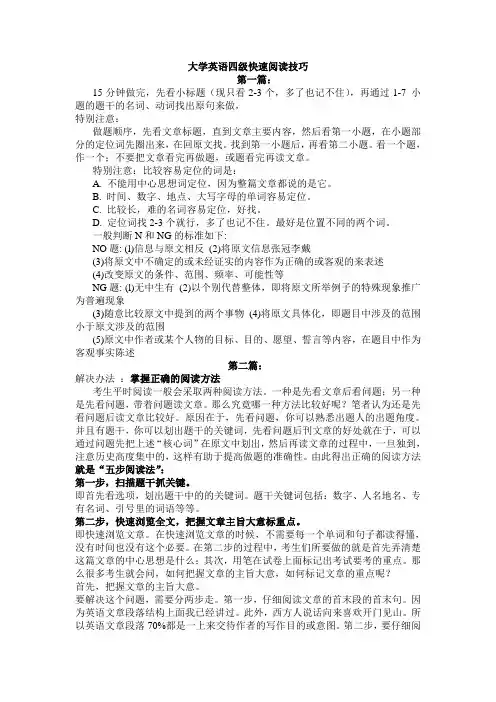
大学英语四级快速阅读技巧第一篇:15分钟做完,先看小标题(现只看2-3个,多了也记不住),再通过1-7 小题的题干的名词、动词找出原句来做,特别注意:做题顺序,先看文章标题,直到文章主要内容,然后看第一小题,在小题部分的定位词先圈出来,在回原文找。
找到第一小题后,再看第二小题。
看一个题,作一个;不要把文章看完再做题,或题看完再读文章。
特别注意:比较容易定位的词是:A. 不能用中心思想词定位,因为整篇文章都说的是它。
B. 时间、数字、地点、大写字母的单词容易定位。
C. 比较长,难的名词容易定位,好找。
D. 定位词找2-3个就行,多了也记不住。
最好是位置不同的两个词。
一般判断N和NG的标准如下:NO题: (l)信息与原文相反(2)将原文信息张冠李戴(3)将原文中不确定的或未经证实的内容作为正确的或客观的来表述(4)改变原文的条件、范围、频率、可能性等NG题: (l)无中生有(2)以个别代替整体,即将原文所举例子的特殊现象推广为普遍现象(3)随意比较原文中提到的两个事物(4)将原文具体化,即题目中涉及的范围小于原文涉及的范围(5)原文中作者或某个人物的目标、目的、愿望、誓言等内容,在题目中作为客观事实陈述第二篇:解决办法:掌握正确的阅读方法考生平时阅读一般会采取两种阅读方法。
一种是先看文章后看问题;另一种是先看问题,带着问题读文章。
那么究竟哪一种方法比较好呢?笔者认为还是先看问题后读文章比较好。
原因在于,先看问题,你可以熟悉出题人的出题角度。
并且有题干,你可以划出题干的关键词,先看问题后刊文章的好处就在于,可以通过问题先把上述“核心词”在原文中划出,然后再读文章的过程中,一旦独到,注意历史高度集中的,这样有助于提高做题的准确性。
由此得出正确的阅读方法就是“五步阅读法”:第一步,扫描题干抓关键。
即首先看选项,划出题干中的的关键词。
题干关键词包括:数字、人名地名、专有名词、引号里的词语等等。
第二步,快速浏览全文,把握文章主旨大意标重点。
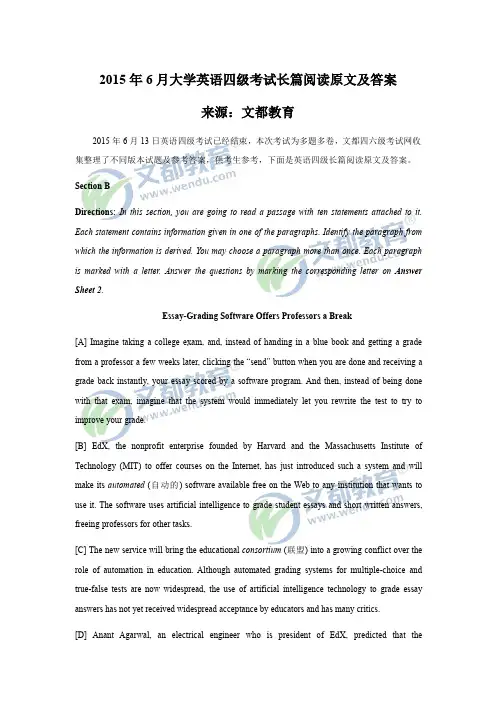
2015年6月大学英语四级考试长篇阅读原文及答案来源:文都教育2015年6月13日英语四级考试已经结束,本次考试为多题多卷,文都四六级考试网收集整理了不同版本试题及参考答案,供考生参考,下面是英语四级长篇阅读原文及答案。
Section BDirections:In this section,you are going to read a passage with ten statements attached to it. Each statement contains information given in one of the paragraphs.Identify the paragraph from which the information is derived.You may choose a paragraph more than once.Each paragraph is marked with a letter.Answer the questions by marking the corresponding letter on Answer Sheet2.Essay-Grading Software Offers Professors a Break[A]Imagine taking a college exam,and,instead of handing in a blue book and getting a grade from a professor a few weeks later,clicking the“send”button when you are done and receiving a grade back instantly,your essay scored by a software program.And then,instead of being done with that exam,imagine that the system would immediately let you rewrite the test to try to improve your grade.[B]EdX,the nonprofit enterprise founded by Harvard and the Massachusetts Institute of Technology(MIT)to offer courses on the Internet,has just introduced such a system and will make its automated(自动的)software available free on the Web to any institution that wants to use it.The software uses artificial intelligence to grade student essays and short written answers, freeing professors for other tasks.[C]The new service will bring the educational consortium(联盟)into a growing conflict over the role of automation in education.Although automated grading systems for multiple-choice and true-false tests are now widespread,the use of artificial intelligence technology to grade essay answers has not yet received widespread acceptance by educators and has many critics.[D]Anant Agarwal,an electrical engineer who is president of EdX,predicted that theinstant-grading software would be a useful teaching tool,enabling students to take tests and write essays over and over and improve the quality of their answers.He said the technology would offer distinct advantages over the traditional classroom system,where students often wait days or weeks for grades.“There is a huge value in leaning with instant feedback,”Dr.Agarwal said.“Students are telling us they learn much better with instant feedback.”[E]But skeptics(怀疑者)say the automated system is no match for live teachers.One longtime critic,Les Perelman,has drawn national attention several times for putting together nonsense essays that have fooled software grading programs into giving high marks.He has also been highly critical of studies claiming that the software compares well to human graders.[F]He is among a group of educators who last month began circulating a petition(呼吁)opposing automated assessment software.The group,which calls itself Professsionals Against Machine Scoring of Student Essays in High-Stakes Assessment,has collected nearly2,000signatures, including some from famous people like Noam Chomsky.[G]“Let’s face the realities of automatic essay scoring,”the group’s statement reads in part.“Computers cannot‘read’.They cannot measure the essentials of effective written communication: accuracy,reasoning,adequacy of evidence,good sense,ethical(伦理的)position,convincing argument,meaningful organization,and clarity,among others.”.[H]But EdX expects its software to be adopted widely by schools and universities.It offers free online classes from Harvard,MIT and the University of Californian-Berkeley;this fall,it will add classes from Wellesley,Georgetown and the University of Texas.In all,12universities participate in EdX,which offers certificates for course completion and has said that it plans to continue to expand next year,including adding international schools.[I]The EdX assessment tool requires human teachers,or graders,to first grade100essays or essay questions.The system then uses a variety of machine-learning techniques to train itself to be able to grade any number of essays or answers automatically and almost instantly.The software will assign a grade depending on the scoring system created by the teacher,whether it is a letter grade or numerical(数字的)rank.[J]EdX is not the first to use the automated assessment technology,which dates to earlycomputers in the1960s.There is now a range of companies offering commercial programs to grade written test answers,and four states—Louisiana,North Dakota,Utah and West Virginia—are using some form of the technology in secondary schools.A fifth,Indiana,has experimented with it.In some cases the software is used as a“second reader,”to check the reliability of the human graders.[K]But the growing influence of the EdX consortium to set standards is likely to give the technology a boost.On Tuesday,Stanford announced that is would work with EdX to develop a joint educational system that will make use of the automated assessment technology.[L]Two start-ups,Coursera and Udacity,recently founded by Stanford faculty members to create “massive open online courses,”or MOOCs,are also committed to automated assessment systems because of the value of instant feedback.“It allows students to get immediate feedback on their work,so that learning turns into a game,with students naturally gravitating(吸引)toward resubmitting the work until they get it right,”said Daphne Koller,a computer scientist and a founder of Coursera.[M]Last year the Hewlett Foundation,a grant-making organization set up by one of the Hewlett-Packard founders and his wife,sponsored two$100,000prizes aimed at improving software that grades essays and short answers.More than150teams entered each category.A winner of one of the Hewlett contests,Vik Paruchuri,was hired by EdX to help design its assessment software.[N]“One of our focuses is to help kids learn how to think critically,”said Victor Vuchic,a program officer at the Hewlett Foundation.“It’s probably impossible to do that with multiple-choice tests. The challenge is that this requires human graders,and so they cost a lot more and they take a lot more time.”[O]Mark D.Shermis,a professor at the University of Akron in Ohio,supervised the Hewlett Foundation’s contest on automated essay scoring and wrote a paper about the experiment.In his view,the technology—though imperfect—has a place in educational settings.[P]With increasingly large classes,it is impossible for most teachers to give students meaningful feedback on writing assignments,he said.Plus,he noted,critics of the technology have tended tocome from the nation’s best universities,where the level of teaching is much better than at most schools.[Q]“Often they come from very famous institutions where,in fact,they do a much better job of providing feedback than a machine ever could,”Dr.Shermis said.“There seems to be a lack of appreciation of what is actually going on in the real world.”注意:此部分试题请在答题卡2上作答。
大学英语四级阅读理解题及解析2015年大学英语四级阅读理解题及解析Merchant and passenger ships are generally required to have a life preserver for every person aboard and in many cases, a certain percentage of smaller sizes for children. According to United States requirements, life preservers must design, reversible capable of being quickly adjusted to fit the uninitiated individual, and must be so designed as to support the wearer in the water in an upright or slightly backward position.Sufficient buoyancy(浮力) to support the wearer should be retained by the life preserver after 48 hours in the water, and it should be reliable even after long period of storage. Thus it should be made of materials resistant to sunlight, gasoline, and oils, and it should be not easily set on fire.?The position in which the life preserver will support a person who jumps or falls into the water is most important, as is its tendency to turn the wearer in the water from a face-down position to an upright or slightly backward position, with his face clear of the water, even when the wearer is exhausted or unconscious.The method of adjustment to the body should be simple, and self-evident to uninitiated persons even in the dark under the confused conditions, which follow a disaster. Thus, the life be reversible that it is nearly impossible to get it on wrong. Catches, straps, and ties should be kept to a minimum. In addition, the life preserver must be adjustable to the wide variety of shapes and sizes of wearers, since this greatly affects the position of floating and the self-righting qualities. A suitable life also be comfortable to wear at all times, in and out of the water, not so heavy as to encourage to take it off on shipboard while the ship is in danger,nor so burdensome that it hinders a person in the water while trying to swim.1. The passage is mainly about____.A) the uses of life preserversB) the design of life preserversC) the materials for life preserversD) the buoyancy of life preservers2. According to the passage, a life be first of all ____.A) adjustable B) comfortable C) self-evident D) self-righting3. United States Coast Guard does NOT require the life preserver to be made ____.A) with as few strings as possibleB) capable of being worn on both sidesC) according to each wearer's sizeD) comfortable and light to wear4. By “the uninitiated individual” (Para. 1, Line. 4) the author refers to the person ____.A) who has not been instructed how to use a life preserverB) who has a little experience in using a life preserverC) who uses a life preserver without permissionD) who becomes nervous before a disaster5. What would happen if a person were supported by the life preserver in a wrong position?A) The waves would move him backwards.B) The water would choke him.C) He would immediately sink to the bottom.D) He would be exhausted or unconscious.答案与解析:1. B文章主要讲述了救生衣的设计。
大学英语四级仔细阅读训练附答案导读:我根据大家的需要整理了一份关于《大学英语四级仔细阅读训练附答案》的内容,具体内容:下面是我整理的,希望对大家有帮助。
Psychiatrists (精神病专家) who work with older parents say that maturity can...下面是我整理的,希望对大家有帮助。
Psychiatrists (精神病专家) who work with older parents say that maturity can be an asset in child rearing-older parents are more thoughtful, use less physical discipline and spend more time with their children. But raising kids takes money and energy. Many older parents find themselves balancing their limited financial resources, declining energy and failing health against the growing demands of an active child. Dying and leaving young children is probably the older parents biggest, and often unspoken, fear. Having late-life children, says an economics professor, often means parents, particularly fathers, "end up retiring much later." For many, retirement becomes an unobtainable dream.Henry Metcalf, a 54-year-old journalist, knows it takes money to raise kids. But hes also worried that his energy will give out first. Sure, he can still ride bikes with his athletic fifth grader, but hes learned that young at heart doesnt mean young. Lately hes beentaking afternoon naps (午睡) to keep up his energy. "My body is aging," says Metcalf. "You cant get away from that."Often, older parents hear the ticking of another kind of biological clock. Therapists who work with middle-aged and older parents say fears about aging are nothing to laugh at. "They worry theyll be mistaken for grandparents, or that theyll need help getting up out of those little chairs in nursery school," says Joann Galst, a New York psychologist. But at the core of those little fears there is often a much bigger one: "that they wont be alive long enough to support and protect their child," she says.Many late-life parents, though, say their children came at just the right time. After marrying late and undergoing years of fertility (受孕) treatment, Marilyn Nolen and her husband. Randy, had twins. "We both wanted children," says Marilyn, who was 55 when she gave birth. The twins have given the couple what they desired for years, "a sense of family." Kids of older dads are often smarter, happier and more sociable because their fathers are more involved in their lives. "The dads are older, more mature," says Dr. Silber, "and more ready to focus on parenting."36. Why do psychiatrists regard maturity as an asset in child rearing?A) Older parents are often better prepared financially.B) Older parents can take better care of their children.C) Older parents are usually more experienced in bringing up their children.D) Older parents can better balance their resources against childrens demands.37. What does the author mean by saying "For many, retirement becomes an unobtainable dream" (Lines 7-8, Para. 1)?A) They are reluctant to retire when they reach their retirement age.B) They cant obtain the retirement benefits they have dreamed of.C) They cant get full pension unless they work some extra years.D) They have to go on working beyond their retirement age.38. The author gives the example of Henry Metcalf to show that ________.A) older parents should exercise more to keep up with their athletic childrenB) many people are young in spirit despite their advanced ageC) older parents tend to be concerned about their aging bodiesD) taking afternoon naps is a good way to maintain energy39. Whats the biggest fear of older parents according to New York psychologist Joan Galst?A) Approaching of death.B) Slowing down of their pace of life.C) Being laughed at by other people.D) Being mistaken for grandparents.40. What do we learn about Marilyn and Randy Nolen?A) They thought they were an example of successful fertility treatment.B) Not until they reached middle age did they think of having children.C) Not until they had the twins did they feel they had formed a family.D) They believed that children born of older parents would be smarter.36. C 37. D 38. C 39.A 40. CCommunications technologies are far from equal when it comes to conveying the truth. The first study to compare honesty across a range of communication media has fund that people are twice as likely to tell lies in phone conversations as they are in emails. The fact that emails are automatically recorded—and can come back to haunt (困扰) you—appears to be the key to the finding.Jeff Hancock of Cornell University in Ithaca, New York, asked 30 students to keep a communications diary for a week. In it they noted the number of conversations or email exchanges they had lasting morethan 10 minutes, and confessed to how many lies they told. Hancock then worked out the number of lies per conversation for each medium. He found that lies made up 14 per cent of emails, 21 per cent of instant messages, 27 per cent of face-to-face interactions and an astonishing 37 per cent of phone calls.His results to be presented at the conference on human-computer interaction in Vienna, Austria, in April, have surprised psychologists. Some expected emailers to be the biggest liars, reasoning that because deception makes people uncomfortable, the detachment (非直接接触) of emailing would make it easier to lie. Others expected people to lie more in face-to-face exchanges because we are most practised at that form of communication.But Hancock says it is also crucial whether a conversation is being recorded and could be reread, and whether it occurs in real time. People appear to be afraid to lie when they know the communication could later be used to hold them to account, he says. This is why fewer lies appear in email than on the phone.People are also more likely to lie in real time—in a instant message or phone call, say—than if they have time to think of a response, says Hancock. He found many lies are spontaneous (脱口而出的) responses to an unexpected demand, such as: "Do you like my dress?"Hancock hopes his research will help companies work our the best ways for their employees to communicate. For instance, the phone might be the best medium foe sales where employees are encouraged to stretch the truth. But, given his result, work assessment where honesty is a priority, might be best done using email.57. Hancocks study focuses on ________.A) the consequences of lying in various communications mediaB) the success of communications technologies in conveying ideasC) people are less likely to lie in instant messagesD) peoples honesty levels across a range of communications media58. Hancocks research finding surprised those who believed that ________.A) people are less likely to lie in instant messagesB) people are unlikely to lie in face-to-face interactionsC) people are most likely to lie in email communicationD) people are twice as likely to lie in phone conversations59. According to the passage, why are people more likely to tell the truth through certain media of communication?A) They are afraid of leaving behind traces of their lies.B) They believe that honesty is the best policy.C) They tend to be relaxed when using those media.D) They are most practised at those forms of communication.60. According to Hancock the telephone is a preferable medium for promoting sales because ________.A) salesmen can talk directly to their customersB) salesmen may feel less restrained to exaggerateC) salesmen can impress customers as being trustworthyD) salesmen may pass on instant messages effectively61. It can be inferred from the passage that ________.A) honesty should be encouraged in interpersonal communicationsB) more employers will use emails to communicate with their employeesC) suitable media should be chosen for different communication purposesD) email is now the dominant medium of communication within a company57. D 58. A 59. A 60.B 61. C。
英语四级快速阅读一、测试目的快速阅读,顾名思义,它的目的在于测试考生单位时间当中的阅读量,其实四级对速度的考查是近几年一直延续的一种结果。
在2002年的时候,我们四级阅读平均每一篇文章阅读量是284个单词,2003年6月,每篇文章阅读量是300个单词。
2005年一月份和六月份,平均阅读量是320到333个单词。
这说明一点,四级考试委员会对阅读速度这个能力早就有一个延续性的逐步的提高。
同时,在解答题目方面,快速阅读并不强调一定要像精读文章那样通篇认真研究,相反,快速阅读题目更强调测试考生在实践语言环境中查询有效信息的能力,这也反映出四六级考试试图提升考生实际应用能力的改革方向。
二、测试形式快速阅读要求考生在15分钟内完成一篇1100字左右的文章和后面的10道题。
前面7个题是判断正误(包括NOT GIVEN),后3个是填空题填根据阅读的理解,填三到四个单词(答案基本都是原文中出现的原词)。
快速阅读的文章一般分为小标题+题目和无小标题+题目两种类型。
这反映出四级考试从单纯的模仿托福的形式转向托福和雅思学习的融合。
该题型需要通过略读和寻读法,乃至文章逻辑关系、标点符号等方面的综合运用,实现对随后的题目有效的判断和填写。
三、基本要求1.快速阅读的文章基本都是专业题材的文章,很多考生可能会觉得很陌生,但是对于CET-4的快速阅读开始来说,只要求考生对题目所提到的信息在原文中能够找到即可,只是有时需要简单的同义词替换2.略读(Skimming)和寻读(Scanning)的能力在大学英语四级考试中显得尤为重要3.快速阅读要求考生的阅读速度是每分钟110-140词四、阅读步骤第一步:略读全文,确定结构快速浏览文章的开头第一段以及各部分的小标题,搞清文章的大体结构和主要内容(一般都可以判断第一道主旨题目的答案)第二步:分析问题,原文定位顺序做每一道小题,正确理解题目所表达的内容,根据题目中的关键词——题眼,在文中找到相应的位置(可以将小标题、数字、人名等信息作为题眼)第三步:分解对应,四项对比找到题目在文章中的出处后,将题干的句子进行简单的成分划分,然后将句子的主谓宾各个部分与原文对应,判断Y、N、NG第四步:分解问题,填写准确对于填空题,先看所缺的句子成分,然后根据小标题或者题眼找到原文。
大学英语四六级仔细阅读真题及参考答案来源:文都图书英语四六级考试中,阅读和听力占的分值比较重,为了帮助同学们能够顺利通关英语四六级考试,文都图书帮助大学分享了2015年6月份大学英语四六级仔细阅读真题及参考答案,希望能够帮助备考路上的你!在此,给大家介绍一本主书,2015《大学英语四级考试真题精析与标准预测》以及2015《大学英语六级考试真题精析与标准预测》,不仅包含最新的9套真题和3套标准预测卷,涵盖诸如词汇、听力、选词填空、阅读理解、翻译、写作等,帮助考生在短时间内全方位提升同学们的英语水平。
Passage TwoQuestions 61-65 are based on the following passage.Some of the world’s most significant problems never hit headlines.One example comes from agriculture. Food riots and hunger make news. But the trend lying behind these matters is rarely talked about. This is the decline in the growth in yields of some of the world’s major crops.A new study by the University of Minnesota and McGill University in Montreal looks at where, and how far, this decline is occurring.The authors take a vast number of data points for the four most important crops: rice, wheat corn and soybeans(大豆). They find that on between 24% and 39% of all harvested areas, the improvement in yields that tood place before the 1980s slowed down in the 1990s and 2000s.There are two worrying features of the slowdown. One is that it has been particularly sharp in the world’s most populous(人口多的) countries, India and China. Their ability to feed themselves has been an important source of relative stability both within the countries and on world food markets. That self-sufficiency cannot be taken for granted if yields continue to slow down or reverse.Second, yield growth has been lower in wheat and rice than in corn and soyabeans. This is problematic because wheat and rice are more important as foods, accounting for around half of all calories consumed. Corn and soyabeans are more important as feed grains. The authors note that “we have preferentially focused our cropimprovement efforts on feeding animals and cars rather than on crops that feed people and are the basis of food security in much of the world.”The report qualifies the more optimistic findings of another new paper which suggests that the world will not have to dig up a lot more land for farming in order to feed 9 billion people in 2050, as the Food and Agriculture Organisation has argued.Instead, it says, thanks to slowing population growth, land currently ploughted up for crops might be able to revert(回返)to forest or wilderness. This could happen. The trouble is that the forecast assumes continued improvements in yields, which may not actually happen.注意:此部分试题请在答题卡2上作答。
2015大学英语四级阅读练习题及答案解析(3)We might marvel at the progress made in every field of study, but the methods of testing a person''s knowledge and ability remain as primitive as ever they were. It really is extraordinary that afterall these years, educationists have still failed to device anything more efficient and reliable than examinations. For all the piousclaim that examinations text what you know, it is common knowledgethat they more often do the exact opposite. They may be a good meansof testing memory, or the knack of working rapidly under extreme pressure, but they can tell you nothing about a person''s trueability and aptitude.As anxiety-makers, examinations are second to none. That is because so much depends on them. They are the mark of success of failure in our society. Your whole future may be decided in onefateful day. It doesn''t matter that you weren''t feeling very well,or that your mother died. Little things like that don''t count: the exam goes on. No one can give of his best when he is in mortal terror, or after a sleepless night, yet this is precisely what theexamination system expects him to do. The moment a child begins school, he enters a world of vicious competition where success and failure are clearly defined and measured. Can we wonder at the increasing number of ''drop-outs'': young people who are written off as utter failures before they have even embarked on a career? Can we be surprised at the suicide rate among students?A good education should, among other things, train you to thinkfor yourself. The examination system does anything but that. What has to be learnt is rigidly laid down by a syllabus, so the student is encouraged to memorize. Examinations do not motivate a student toread widely, but to restrict his reading; they do not enable him to seek more and more knowledge, but induce cramming. They lower the standards of teaching, for they deprive the teacher of all freedoms. Teachers themselves are often judged by examination results and instead of teaching their subjects, they are reduced to trainingtheir students in exam techniques which they despise. The most successful candidates are not always the best educated; they are the best trained in the technique of working under duress.The results on which so much depends are often nothing more thana subjective assessment by some anonymous examiner. Examiners areonly human. They get tired and hungry; they make mistakes. Yet they have to mark stacks of hastily scrawled scripts in a limited amount of time. They work under the same sort of pressure as the candidates. And their word carries weight. After a judge''s decision you have the right of appeal, but not after an examiner''s. There must surely be many simpler and more effective ways of assessing a person''s true abilities. Is it cynical to suggest that examinations are merely a profitable business for the institutions that run them? This is what it boils down to in the last analysis. The best comment on the system is this illiterate message recently scrawled on a wall: ''I were a teenage drop-out and now I are a teenage millionaire.''1. The main idea of this passage is ______[A] examinations exert a pernicious influence on education.[B] examinations are ineffective.[C] examinations are profitable for institutions.[D] examinations are a burden on students.2. The author''s attitude toward examinations is ______[A]detest.[B] approval.[C] critical.[D] indifferent.3. The fate of students is decided by ______[A] education.[B] institutions.[C] examinations.[D] students themselves.4. According to the author, the most important of a good education is ______[A] to encourage students to read widely.[B] to train students to think on their own.[C] to teach students how to tackle exams.[D] to master his fate.5. Why does the author mention court? ______[A] Give an example.[B] For comparison.[C] It shows that teachers'' evolutions depend on the results of examinations.[D] It shows the results of court is more effectise.Vocabulary1. knack 窍门,诀窍2. embark 乘船,登记3. write off 勾销,注销。
大学英语四级考试阅读理解No1一、原选择题型的篇章阅读理解新四级的仔细阅读增加了文章的长度和段落数量,题型向细节性方向发展。
仔细阅读要求做到“三精读一略读”。
一是精读文章首段和每段第一次出现的结论句,了解文章的主题和结构。
二是精读关键词定位的地方,请注意,细节题题干都是相应原文的变形(如同义改写、词性转换等)。
因此要找到答案一定要找到题干在原文中的出处,再把原文和选项相比较,正确选项应该是对原文的精确改写,应该符合两点特征:形式对应和含义对应,比如原文中出现比较,那么正确选项中也应该对应出现相应形式,同时含义应该是原文的同义替换,相同的意思换了一种表达方式。
三是精读重要考点,比如:转折、比较、因果、结论或总结。
略读就是略读甚至不读其他细节性信息,因为干扰选项往往来自于这些地方,精读后反而会增加干扰选项的迷惑度,避免被迷惑信息干扰的最好方法就是不去面对诱惑。
需要注意的是与原文极其相似的选项一定要慎选。
四级阅读考查的题型主要是细节题,另外还会涉及态度题,主旨题,推理题,结论观点题,词汇题等。
各类题型表现形式不同,考查重点各异,解题方法有别。
1.细节题(1)、细节题表现形式这类题在四级考试中题量较大,占到60%——70%的题量,可以说是四级考试成败的关键这类题特点是题干的信息比较具体,考查文章中的重要细节。
如2005年1月份考题:“Free play has been introduced in someJapanese kindergartens in order to”,本题通过“free play”,“some Japanese kindergartens”反映了原文考查对象,题干内容比较具体,属于细节分析。
又如2005年6月份出现的题目:“What did the handball player do when he was not allowed a time out to change his gloves? ”本题handball player 是中心话题,when引导状语从句,这两部分明确指定了考查的细节内容,在原文中找答案十分方便。